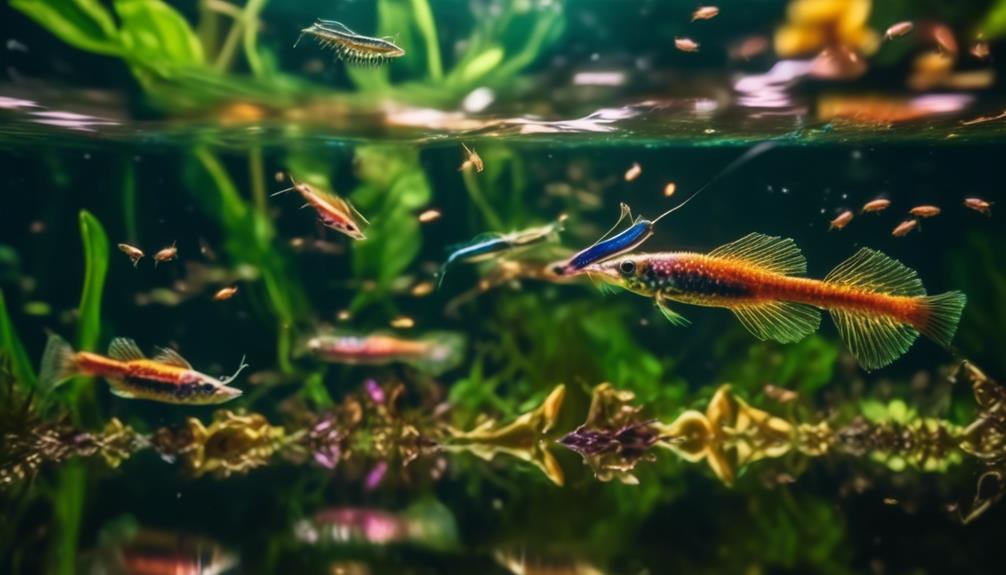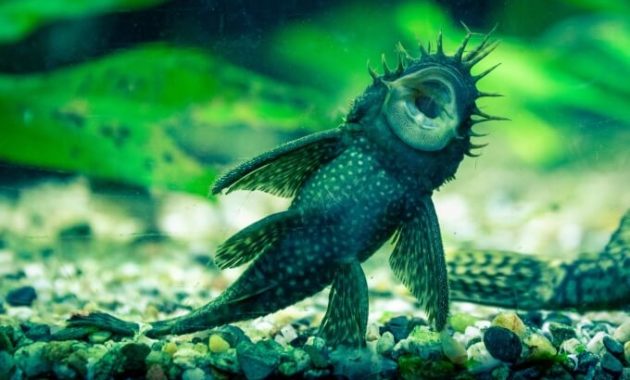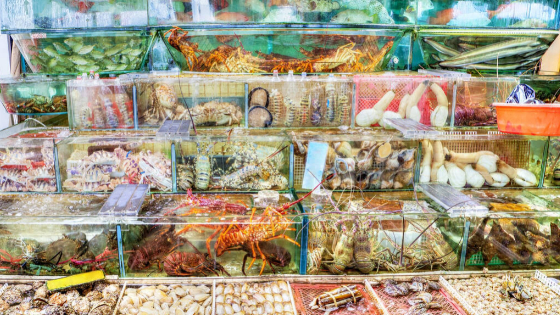
Are you tired of your aquarium looking dull and lacking vibrancy?
Picture this: a small freshwater fish with stunning colors that will instantly brighten up your tank.
Darters, similar to perch, are the answer you’ve been searching for. These captivating fish can be found in freshwater streams all across North America, bringing a burst of color and life to any aquarium.
But it doesn’t stop there. Darters have a fascinating array of colorations and markings that are guaranteed to leave you in awe.
So, if you’re ready to dive into the world of darters and discover how they can transform your aquarium, keep reading.
Key Takeaways
- Darters are small freshwater fish found in North America, growing to around 3 inches in length.
- They prefer cool, slightly alkaline water conditions and should be kept in tanks with at least 20 gallons of water.
- Mimicking their natural habitat with sandy substrate, rock piles, and caves is important for their well-being.
- Darters are insectivorous and thrive on a diet rich in live or frozen foods, such as daphnia, brine shrimp, and bloodworms.
General Information About Darters
Darters, small freshwater fish similar to perch, can be found in freshwater streams throughout North America. They grow to around 3 inches in length and are often kept in community tanks. Darters prefer cool, slightly alkaline water conditions. They’re most commonly found in the Mississippi River Basin, although some species are endemic to specific streams.
Darters come in various colors such as brown, tan, green, black, or gray, with spots or markings on their bodies and fins. To care for darters, provide them with rock piles for hiding and sandy substrate in the aquarium. They enjoy cool, clean water with the ideal pH level varying by species.
Darters are insectivorous and can be fed sinking wafers, pellets, and live or frozen foods.
Origins and Habitat of Darters

After learning about the general information and care requirements of darters, it’s time to explore their origins and natural habitat. Darters are most commonly found in the Mississippi River Basin, but some species are endemic to specific streams. They prefer clear, fast-flowing waters with low pollution levels. To help you visualize their habitat, here is a table showcasing the origins and habitat preferences of darters:
| Origin | Habitat Preference |
|---|---|
| Mississippi River Basin | Clear, fast-flowing waters with low pollution |
| Endemic to streams | Specific streams with similar conditions |
Understanding the origins and habitat of darters is crucial in providing the best care for these colorful fish. By recreating their natural environment in your aquarium, you can ensure that darters thrive and brighten your underwater world.
Darters’ Colorful and Diverse Coloration

With their vibrant hues and varied patterns, darters showcase a stunning array of colors in aquariums. Their colorful and diverse coloration is truly captivating. Here are some fascinating facts about darters’ coloration:
- Various Colorations:
- Darters come in a range of colors including brown, tan, green, black, and gray.
- Many species have beautiful spots or markings on their bodies and fins.
- Camouflage and Display:
- Some darters have evolved to blend in with their surroundings, using their coloration as camouflage.
- On the other hand, certain species boast bright and eye-catching colors, which they use for display and courtship.
These striking colors add vibrancy and visual interest to aquariums, making darters a popular choice for fish enthusiasts. Whether they blend in or stand out, these colorful fish are sure to brighten up any aquarium setting.
Maintenance and Care Tips for Darters

To ensure the health and well-being of your darters, proper maintenance and care are essential. Darters enjoy aquariums with rock piles for hiding places and sandy substrate. It is recommended to provide cool, clean water in the aquarium, with the ideal pH level varying depending on the species. Ensuring high water quality is crucial, requiring frequent water changes. Darters are insectivorous and can be fed sinking wafers, pellets, and live or frozen foods. To help you understand the specific care needs of darters, here is a table summarizing their maintenance requirements:
| Maintenance Tips | Care Tips |
|---|---|
| Provide hiding places with rock piles | Regularly monitor water temperature |
| Use sandy substrate | Check and maintain water pH levels |
| Ensure cool, clean water | Perform frequent water changes |
| Feed sinking wafers, pellets, and live or frozen foods | Monitor darters’ health and behavior |
| Maintain high water quality | Seek professional advice if needed |
Feeding Habits of Darters

Darters have diverse feeding habits, varying from species to species. When it comes to feeding your darters, there are a few things to keep in mind:
- Diet Variation:
- Darters are insectivorous and thrive on a diet rich in live or frozen foods.
- Offer them a variety of options, including daphnia, brine shrimp, bloodworms, and small insects.
- Sinking Wafers and Pellets:
- Supplement their diet with sinking wafers and pellets specially formulated for small fish.
- These provide essential nutrients and ensure a balanced diet for your darters.
Remember to observe your darters while feeding to ensure they’re eating properly. It’s important to feed them the right amount to prevent overfeeding and maintain water quality.
Breeding Habits of Darters

Breeding darters requires careful consideration of their unique reproductive behaviors. These small freshwater fish are egg layers and typically spawn over rocky areas. Unlike some fish species, darters don’t display parental care once the eggs have hatched.
Each species of darters may have different breeding habits, so it’s important to research and understand the specific requirements for successful breeding. Some darters may require particular water conditions or temperature changes to trigger breeding behavior. Additionally, providing suitable hiding spots and environments that mimic their natural habitat can encourage spawning.
It’s also important to note that darters may require a separate breeding tank to ensure the safety of the eggs and to prevent other fish from consuming them.
Choosing the Right Aquarium Setup for Darters

When setting up an aquarium for darters, it’s important to consider the specific requirements for creating the right environment. Here are some key factors to keep in mind:
- Tank Size and Setup:
- Darters are small fish, so a tank size of at least 20 gallons is suitable.
- Provide plenty of hiding places with rock piles and caves.
- Use a sandy substrate to mimic their natural habitat.
- Water Conditions:
- Darters prefer cool water temperatures between 60-75°F.
- Maintain a slightly alkaline pH level around 7.0-8.0.
- Regular water changes are essential to maintain high water quality.
Compatible Tankmates for Darters

To ensure a harmonious aquarium community, it’s important to choose compatible tankmates for your darters. Darters are small, peaceful fish that generally get along well with other non-aggressive species. It’s recommended to avoid larger, aggressive fish that may intimidate or harm the darters.
Good tankmates for darters include small tetras, rasboras, and guppies. These fish share similar water temperature and pH requirements, making them suitable companions. Additionally, bottom-dwelling fish such as corydoras catfish and small loaches can also be compatible tankmates for darters. These fish occupy different areas of the tank and have peaceful temperaments.
Remember to always research the specific needs and behaviors of potential tankmates to ensure a successful and stress-free community for your darters.
Tips for Creating a Beautiful Darter Aquarium

To create a visually stunning darter aquarium, carefully consider the layout and design elements that will enhance the natural beauty of these colorful fish. Here are some tips to help you create a beautiful darter aquarium:
- Choose a suitable tank size: Darters are small fish, so a tank with a capacity of at least 20 gallons is recommended.
- Create a natural habitat: Mimic the darter’s natural environment by using sand or gravel substrate and adding rocks, driftwood, and plants to provide hiding places and create a sense of security.
- Lighting: Use soft, subdued lighting to highlight the vibrant colors of the darters without causing stress.
- Water conditions: Maintain cool, slightly alkaline water with good filtration to ensure the health and well-being of the darters.
- Tankmates: Select compatible fish species that won’t compete for resources or pose a threat to the darters.
Frequently Asked Questions
Can Darters Be Kept in a Saltwater Aquarium?
No, darters cannot be kept in a saltwater aquarium. They are small freshwater fish that prefer cool, slightly alkaline water conditions. It is important to provide them with the right environment for their wellbeing.
Do Darters Require a Lot of Space in an Aquarium?
No, darters don’t require a lot of space in an aquarium. They are small fish, usually around 3 inches long. However, it’s important to provide them with suitable hiding places and clean water.
What Is the Average Lifespan of a Darter Fish?
The average lifespan of a darter fish is around 3 to 5 years. It’s important to provide them with proper care, including a suitable environment, clean water, and a balanced diet to ensure their longevity.
Can Darters Be Kept With Aggressive Tankmates?
Yes, darters can be kept with aggressive tankmates, but it’s important to choose tankmates that are compatible in size and temperament. Monitor their interactions closely to ensure the safety of all fish.
Are Darters Prone to Any Specific Diseases or Health Issues?
Darters, like any fish, can be prone to certain diseases and health issues. It’s important to maintain good water quality, provide proper nutrition, and monitor for any signs of illness or stress.
What Makes Darters and Damselfish So Popular in Aquariums?
Darters and damselfish are popular in aquariums due to their vibrant colors and playful behavior. Their vivid hues and energetic swimming patterns add a lively touch to any tank, enhancing the overall aesthetic. Many aquarium enthusiasts are drawn to the colorful world of damselfish, making them a sought-after addition to marine environments.
Conclusion
In conclusion, darters are a fantastic addition to any aquarium, bringing vibrant colors and unique patterns. With their small size and diverse coloration, they’re perfect for community tanks.
By providing the right habitat, proper care, and a well-designed setup, you can create a beautiful darter aquarium that will impress any observer.
So, don’t hesitate to add these stunning fish to your collection and enjoy the colorful world of darters in your own home.




